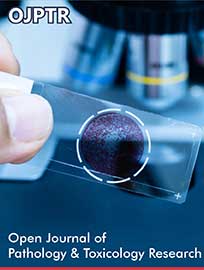 Research Article
Research Article
“Sacred Ganga River and Triveni Sangam Water”: Assessment of water Quality and Suitability
Vibha Bhardwaj*
Director, Environment Laboratories, Ras Al Khaimah Municipality, United Arab Emirates
Vibha Bhardwaj, Director, Environment Laboratories, Ras Al Khaimah Municipality, United Arab Emirates
Received Date:April 05, 2024; Published Date:April 22, 2024
Abstract
Background: The river Ganga, a support for millions, drains one of the world’s insignificant, and most heavily and continuously occupied
watersheds. The river is exploited for drinking, power generation, irrigation, fish production, and religious pilgrimages. The Ganges is the most
sacred river to Hindus. It is worshipped as the goddess Ganga in Hinduism. Millions of pilgrims take holy dip and take bottles of it to their homes.
Triveni Sangam is the confluence of the Ganges (Ganga), the Yamuna, and the legendary Saraswati River. Triveni Sangam is located at Prayag – the
area of Prayag raj. The present investigation was to study the water quality of river Ganga and Triveni Sangam with reference to physicochemical
and heavy metal characterization.
Results: Ganga River water and Triveni Sangam water has a rich mineral composition. The result revealed that among the different sampling
sites, the maximum value of Magnesium (11.06 mg/L), Calcium (43.68 ± 0.3 mg/L), Sodium (43.65 ± 0.1 mg/L), Potassium (5.409 ± 0.2 mg/L),
Sulphate (40 ± 0.1 mg/L), Nitrate (1.6 ± 0.1 mg/L), Phosphorous (0.26 ± 0.1 mg/L) were recorded higher at Triveni Sangam water (TSW) in
comparison to Ganga water (GW) sampling sites which showed maximum value of Aluminum (0.0174 ± 0.3 mg/L), Zinc (0.0058± 0.2 mg/L), Silver
(0.0011± 0.2 mg/L).Experimental studies indicate that Ganga River water and Triveni Sangam water is safe.
Conclusion: During the study, it was observed that the water quality of River Ganga was good at most of the locations, even over the years,
increased industrial activities and urban growth along the rivers and lakes have resulted in increased load over the water bodies. But the upper
segment of Ganga and Triveni Sangam had good quality of water to be used for drinking with minimal treatment but after disinfection. Even the
concentration of heavy metals was either non-detectable or within the safe limits. In conclusion the results of present study indicated that Ganga
River water and Triveni Sangam are alkaline mineral water, unpolluted by heavy metals and pesticides, and is safe for use.
Keywords:Metallic profile; ICP-OES analysis; minerals; gas chromatograph mass spectrometer
Abbreviations:SD: Standard Deviation; TSW: Triveni Sangam water; ND: Not Detected; PPM: parts per million; PPT: parts per trillion; BIS: Bureau of Indian standard; GW: Ganga Water
Introduction
India has a distinctive place due to its religious, political, historical, geographical, environmental, socio-cultural, and as an emerging economic power not only in South Asian Countries, but also in the world [1]. All the communities as Hindus, Muslims, Sikh, and Christians are residing together and celebrated their auspicious events of happiness and sorrows together. Rivers have a great significance and place in Indian civilization. These are considered as live entity and having a place as mother in the life of people in India. The Ganges, one of the most sacred rivers to Hindus.Ganga River originates from Gangotri glacier. It is a valley-type glacier with a length of 30.20 km, and width varying from 0.5 to 2.5 km [2] situated in the Uttarkashi district of Garhwal Himalaya. Ganga river basin is the largest among river basins in India and the fourth largest in the world. River Ganga water is used for irrigation primarily, and as a source for drinking water and industrial applications. It, therefore, becomes imperative to assess the suitability of water for different uses.
Ganga River Rishikesh
The Ganges flows through Rishikesh in its course from the Shivalik Hills of the Himalayas to the plains of northern India with temples built along the banks. People take baths into the holy river and perform their rituals [3]. Rishikesh, unlike other cities, is the first pilgrimage cum tourist destination after the river enters plains, and upstream-located industrial/anthropogenic sources of pollution which may affect the water quality are absent. Any addition upstream of Rishikesh (Figure 1) may be treated as natural. For Hindus in India, the Ganges is not just a river but a mother, a goddess, a tradition, a culture and much more. Some Hindus also believe life is incomplete without bathing in the Ganges at least once in your lifetime.
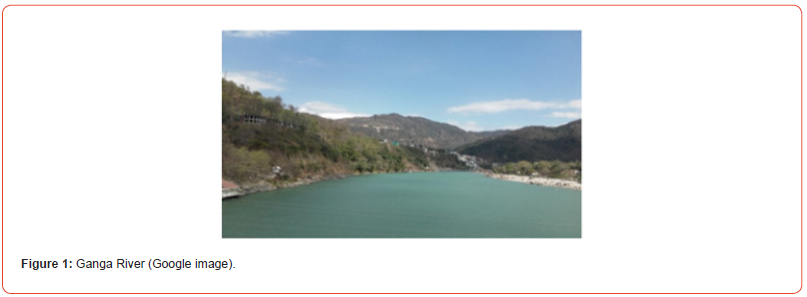
Triveni Sangam Prayagraj
Triveni Sangam is the confluence of the Ganges (Ganga), the Yamuna, and the legendary Saraswati River. Triveni Sangam is located at Prayag, the area of Prayagraj neighbouring the confluence; for this reason, the confluence is also sometimes referred to as Prayag [4]. At Triveni Sangam (Figure 2), the Ganges and the Yamuna can be identified by their different colours – the water of the Ganges is clear while that of the Yamuna is greenish in colour [5]. The third river, the mythical Saraswati, is called invisible.
The auspiciousness of the confluence of two rivers is referred to in the Rigveda, which says, “Those who bathe at the place where the two rivers, white and dark, flow together, rise up to heaven [6]. Therefore, regular monitoring of the water quality of these sacred water bodies is essential to maintain their ecological esthetic and recreational significance. Keeping in view the present case study was undertaken to assess the water quality of River Ganga and Triveni Sangam with reference to physico-chemical, pesticides, and heavy metal characteristics.
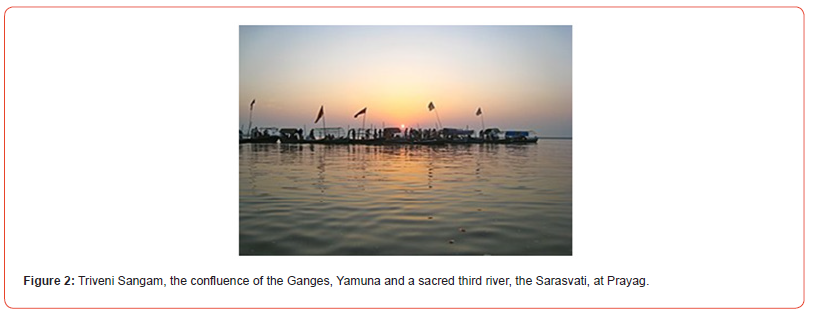
Material and methods
Study Area
River Ganga and Triveni Sangam water was selected for the present study to determine the contamination of heavy metals, pesticides and physico-chemical characteristics in the water. The samples were collected during March 2023 to December 2023 selecting four sampling sites, two samples from each city viz., Rishikesh, Uttarakhand and Prayagraj (Triveni Sangam), Uttar Pradesh.
Reagents
All reagents and chemicals used in this study were of analytical grade. Ultrapure deionized water (Merck Millipore, USA) was used for preparation of reagents and dilution throughout the work. For instrument calibration and standard solutions were purchased from Analytic Jena, Germany. Chemicals used were purchased from Merck (Darmstadt, Germany) and Sigma- Aldrich (St. Louis, MO, USA). GCMS calibration and standard solutions were purchased from Shimadzu, Japan. Nutrient analysis kits e.g., nitrate, phosphorous, sulphate, total hardness, chloride was purchased from HACH, USA.
Sample Collection
Total four Samples were collected from four different sites, two samples from each city i.e. Rishikesh, Uttarakhand and Prayagraj, Uttar Pradesh. Two locations were selected from Rishikesh city to collect samples viz. Muni ki Reti and Shivpuri (GW1 and GW2). The another two samples were collected from Triveni Sangam of Prayagraj (TSW1 and TSW2), where the “three-river confluence” the Ganges, Yamuna, and the mythical Sarasvati. The four samples were collected in 1 L bottles; labelled and stored in room temperature (Figure 3).
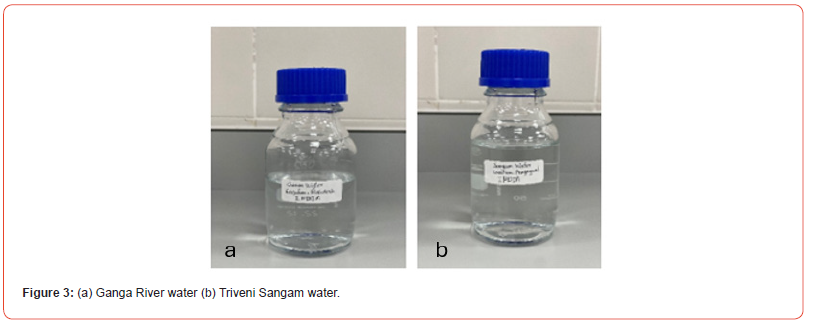
Sample Preparation
After collection, each water samples were divided into two portions. The first was used for determination of pH, Total Dissolved Salts (TDS) and levels of chloride, total hardness, sulphate, nitrate, and phosphorous. The second part was processed for heavy metal and pesticide analysis. All analyses were carried out within a week of sample collection.
Physicochemical, Metallic Profile and Pesticides Analysis
All water samples were analysed for pH, salinity, Nitrate, Sulphate, Phosphorous, heavy metal concentration, and pesticides. The pH, salinity, TDS, conductivity was measured with WTW 3430 multimeter, Germany. Nitrate, Sulphate, Phosphorous, total hardness, chloride concentration was measured by using HACH spectrophotometer DR 3900, USA. Heavy metal concentration was analysed by using ICP-OES Plasma Quant PQ 9000 (Analytic Jena, Germany). Pesticide analysis was performed by using Gas Chromatograph Mass Spectrometer GCMS-QP2020 NX (Shimadzu, Japan).
Quality Control Procedure
All reagents used were of analytical-reagent grade. Reference solutions used in calibration range were prepared from 1000 mg/L standard solutions (Analytic Jena, Germany) [7]. In case of GCMS, Certified Reference Material for pesticide (Shimadzu, Japan) was used to control the quality of measurements. This reference material was analyzed at regular intervals (monthly) during sample analysis to assess the accuracy. Triplicate measurements of each sample were done. The precision of analysis was assessed by calculation of relative standard deviations (RSD). Recovery of the analyte from spiked samples was used to evaluate accuracy of the procedure.
Statistical Analysis
The experiments were performed in triplicates. Data are expressed as mean. Pair wise comparisons were performed. Experimental error was determined for triplicate and expressed as standard deviation (SD).
Results
This study provided a valuable data concerning the assessment and awareness of quality of Ganga River and Triveni Sangam water with nutrient, metallic profile, and pesticides.
Physicochemical characteristics of Ganga River and Triveni Sangam water
According to our research analysis, the average concentrations of all analytes (water samples) were within the permissible limits of the BIS standard (Table 1). Ganga River water and Triveni Sangam has a rich mineral composition. The result revealed that among the different sampling sites, the maximum value of Magnesium (11.06 mg/L), Calcium (43.68 ± 0.3 mg/L), Sodium (43.65 ± 0.1 mg/L), Potassium (5.409 ± 0.2 mg/L), Sulphate (40 ± 0.1 mg/L), Nitrate (1.6 ± 0.1 mg/L), Phosphorous (0.26 ± 0.1 mg/L) were recorded higher at Triveni Sangam Water (TSW) in comparison to Ganga Water (GW) sampling sites which showed maximum value of Aluminium (0.0174 ± 0.3 mg/L), Zinc (0.0058± 0.2 mg/L), Silver (0.0011± 0.2 mg/L). Heavy metals like Lead, Indium, nickel, manganese, cadmium, cobalt, chromium was not detected (Table 1).
Pesticides analysis of Ganga River and Triveni Sangam water
According to our research analysis GCMS was used for pesticides detection i.e. α-BHC, γ-BHC (Lindane), β-BHC, δ-BHC, Heptachlor, Aldrin, Heptachlor epoxide (isomer B), cis-Chlordane, trans- Chlordane, 4,4’-DDD, 4,4’-DDE, 4,4’-DDT, Dieldrin, Endosulfan I, Endosulfan II, Endosulfan sulfate, Endrin, Endrin aldehyde, Endrin ketone, Methoxychlor but, no pesticides were detected in all the four water samples.
Discussion
The present study was conducted for the multi-elemental, pesticide analysis of Ganga River water and Triveni Sangam water which was analyzed by Inductively Coupled Plasma Optical Emission spectroscopy (ICP-OES), nutrient analysis by HACH spectrophotometer DR 3900, pesticides by GCMS. The results of the present study pointed that chemical composition of GW and TSW are acceptable according to guidelines of Bureau of Indian standard for drinking water. Differences among studies could be explained by many factors such as differences in the laboratory methods used for water analysis, material used due to variable water samples, ways of collection, season, or the preservation of water in bottles and the source of the samples. According to the present research work, it was found that the pH values of Ganga River water and TSW were in the range of 7.16–7.29 indicating that the water is slightly alkaline, at different sampling sites and it was likely due to the use of detergents by the pilgrims during the holy bath which is similar in result with [8] several studies have conferred the process by which alkaline water promotes healing.
For example, [9] stated that alkaline drinking water plays an important part in get ridding the toxins from the body. The more acidic the body is, the more it holds onto (heavy) metals. Heavy metals in turn create a high oxidative stress that acidifies the body. Subsequently, alkaline water has been used for improving bone density and healing [10]; controlling gastric functions [11]; improving capacity for aerobic activities and flushing toxins and acidic waste [12,13]. Electrical conductivity (EC) represents the concentration of different ions present. In our research findings, EC varied from 315 to 578 μS/cm. Conductivity serve as an indicator of water quality problems. Similar research results of EC agreed with [14] who reported the changes in EC of water of river Ganga during at Haridwar, [15] India. The TDS ranged from 142.0 to 290.0 mg/L. Higher values of TDS at location #TSW1 and #TSW2 may be attributed to addition of sewage, suspension of ashes and flowers used for worship and offering to the deities, near the locations.
The desirable limit for TDS in drinking water is 500 mg/L. Kumar et al., 2018 reported similar results stated that among different sampling sites the most values of TS (545 mg/L), TDS (320 mg/L) and TSS (225 mg/L). Salinity (%) ranged from 0.001074 to 0.010699. Alkalinity of the water exhibited more variation and ranged from 36.0 to 80.0 mg/L. Similar resulted were reported by [16] 2014 stated that Alkalinity of the water exhibited more variation and ranged from 32.0 to 144.0 mg/L. As per the Bureau of Indian Standards (BIS) standards (2012) (Table 1), the limit of alkalinity in drinking water is 200 mg/L. The Total Hardness (TH) in river water is primarily regulated by the carbonates, bicarbonates, chlorides, sulphates, etc. of calcium and magnesium chiefly, whereas there are certain other chemical entities accounting for it. The hardness levels varied from 103.24 to 176.35mg/L. The observations revealed that the major source of hardness ions is the wastewater from domestic use. The desirable limit for total hardness in drinking water, as per BIS, India is 200 mg/L.
These results revealed that wastewater from domestic use had a fair proportion of calcium bound ions adding to total hardness. The contribution of carbonate ions towards hardness was analyzed (Table 1). In the present study, the values of chloride observed at different sites are varied from 11mg/L to 50mg/L which is in the range of BIS standard (2012), the limit of chloride in drinking water is 250mg/L. Higher value of chloride were found in TSW 1 and TSW2. Similar work was done by, studied that the values of chloride (118.36-124.50 mg/L), hardness (221.00-232.54 mg/L) and alkalinity (146.37-158.36 mg/L) was ranged at different sampling sites as Har ki Pauri (HKP), Vishnu Ghat (VG), Daksh Mandir (DM), Pul Jatwara (PJ). In the present study, the values of nitrate (0.77-1.6 mg/L) and sulphate (25-40 mg/L) was ranged at different sampling sites. The values of nitrate and sulphate are in the standard range of BIS drinking water which is 45mg/L and 200mg/L.
Heavy metal Characteristics of Ganga River water and Triveni Sangam water
The heavy metals are at very low concentrations in the natural environment, and they are typically introduced to surface waters as waste from human activities. Heavy metal is another class of pollutants responsible for many of the diseases in exposed organisms. Some of the metals of concern for human and aquatic health are cadmium, lead, copper, mercury, selenium, and chromium etc. Nickel, cobalt, cadmium, Iron, lead, indium, manganese, chromium was not detected in the collected water samples (Table 1). Copper was below the detection limit in all the samples. Copper was present at all the locations and ranged from 0.0062 to 0.0119 mg/L with a limit value of 0.05 mg/L. Maximum concentration was reported in lower stretch TSW1 and TSW2. Similar results were reported by Haritash et al., 2014 which says that Copper was present at all the locations and ranged from 0.0321 to 0.0581 mg/L with an average value of 0.0386 mg/L. [17] stated similar results align with our research, stated that the maximum concentration of copper (0.043 mg/L) [18] who reported the higher contents of copper in abandoned old Ganga canal at Haridwar (Uttarakhand), India [19] also reported higher concentration of copper in the water of sub canal of upper Ganga canal at Haridwar (Uttarakhand), India due to the discharge of untreated textile effluent.
Table 1:summarizes the metallic and nutritional profile content in Ganga water (GW) and Triveni Sangam water (TSW) as well as the recommended values available according to the Bureau of Indian Standards (2012). Specification for drinking water. 1S: 10500, Bureau of Indian Standards, New Delhi.
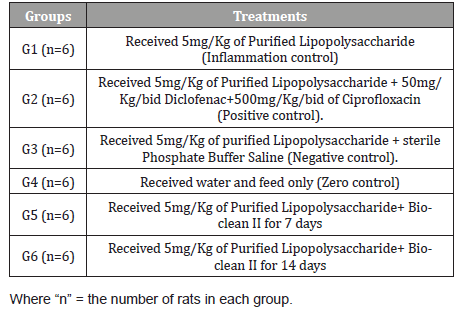
Contrary results were reported by which studied that the values of Cu (0.164-0.171 mg/L), Cr (1.434-1.503 mg/L), Fe (3.501-3.642 mg/L) and Mn (0.627-0.644 mg/L) were ranged at different sampling sites. In our research finding, Zinc concentration varied from 0.0005 to 0.0058 mg/L (Table 1) which is below the [20] standard of drinking water i.e. 5mg/L. Reported minimum zinc concentration as 0.008 mg/L Whereas, maximum zinc value was detected as 0.127 mg/L and it might also be due to a number of anthropogenic activities like mass bathing, discharge of urban waste and runoff etc. as also reported earlier by, In our research findings in all water samples, chromium was not detected. Chromium is considered as one of the essential nutrients for several living organisms only in trace amount [21,22]. The concentration of chromium in drinking water is usually found only at trace level, but chromium (VI) in exceeded concentration is extremely toxic to the consumers from health point of view [23]. Our research findings were similar to which stated that chromium was detected 0.001 mg/L as minimum concentration at all the study sites. The BIS (2012) has prescribed its desirable limit up to 0.05 mg/L, but there is no relaxation beyond this range.
Conclusion
The results of the present study concluded that Ganga River water and Triveni Sangam water has a rich mineral composition. It contains maximum value of Magnesium (11.06 mg/L), Calcium (43.68 ± 0.3 mg/L), Sodium (43.65 ± 0.1 mg/L), Potassium (5.409 ± 0.2 mg/L), Sulphate (40 ± 0.1 mg/L), Nitrate (1.6 ± 0.1 mg/L), Phosphorous (0.26 ± 0.1 mg/L) were recorded higher at Triveni Sangam water (TSW) in comparison to Ganga water (GW) sampling sites which showed maximum value of Aluminium (0.0174 ± 0.3 mg/L), Zinc (0.0058± 0.2 mg/L), Silver (0.0011± 0.2 mg/L). Heavy metals like Lead, Indium, nickel, manganese, cadmium, cobalt, chromium was not detected. No pesticides were detected. During the study, it was observed that the water quality of River Ganga was good at most of the locations in Rishikesh town. The upper segment of Ganga had good quality of water to be used for drinking with minimal treatment but after disinfection. Even the concentration of heavy metals was either non-detectable or within the safe limits. Ganga River water and Triveni Sangam water are alkaline in nature, unpolluted by heavy metals and is safe for use. All metal concentrations in the studied samples were within the acceptable limits according to the Bureau of Indian Standard of drinking water. Efforts are made by the Indian government, [24,25] (National mission for Clean Ganga) and local authorities. More comprehensive research work is required to accomplish the twin objectives of effective abatement of pollution, conservation, and rejuvenation of National River Ganga; To maintain minimum ecological flows in the river Ganga with the aim of ensuring water quality and environmentally sustainable development.
Ethics Approval and Consent to Participate
Not applicable.
Consent for Publication
Not applicable.
Availability of Data and Materials
The relevant data and materials are available in the present study.
Funding
This research received no specific grant from any funding agency in the public, commercial, or not-for-profit sectors.
Acknowledgements
Authors would like to thank all individuals who provided their efforts for this research especially Aayesha Ahmed Alzaabi and Nizamudeen for their assistance during research work.
Declaration of Competing interests
The authors declare that they have no competing interests. All procedures followed were in accordance with the ethical standards (institutional and national). The author declared that there is no specific conflicting financial interest or personal partnership that could have influenced the work presented in article.
Credit Authors’ statement
Dr. Vibha Bhardwaj performed all the experiments. VB analysed the data and wrote the manuscript. Conceptualization, Methodology, Validation, Formal analysis, Investigation, Resources, Supervision, Data curation, writing original draft, Writing review & editing, Visualization.
References
- Yasir, Srivastava S (2016) Monitoring of ground water quality in the province of district Dehradun, (Uttarakhand), India. Archives of Agriculture and Environmental Science 1(1): 43-48.
- National River Conservation Directorate (2009) Status paper on River Ganga: State of Environment and Water Quality. Ministry of Environment and Forests New Delhi.
- Rizwan MK, Srivastava S (2016) Impact of tourism on water quality characteristics of Lidder Stream at Pahalgam, (J&K), India. Archives of Agriculture and Environmental Science 1(1): 37-42.
- "Prayag" (2021) Times of India Travel. Retrieved 25 March.
- Triveni Sangam (2015)
- Eck Diana L (2013) India: A Sacred Geography. Strategic Analysis 37(3): 366-371.
- Bhardwaj V (2023) Sacred Zamzam Water: Metallic Profile and Health Benefits. Biomedical Journal of Scientific & Technical Research 53(1): 2023.
- Kumar V, Kumar S, Srivastava S, Singh J, Kumar P (2018) Water quality of River Ganga with reference to physico-chemical and microbiological characteristics during Kanwar Mela 2017, at Haridwar, India: A case study. Archives of Agriculture and Environmental Science 3(1): 58-63.
- Kellas W, Dworkin A, Kellas W, Dworkin A (1996) Surviving the Toxic Crisis. Comprehensive Health First Edition P, 523.
- Wynn E, Krieg M, Aeschlimann J, Burckhardt P (2009) Alkaline mineral water lowers bone resorption even in calcium sufficiency: alkaline mineral water and bone metabolism. Bone 44(1): 120-124.
- Bertoni M, Oliver F, Manghetti M, Boccolini E, Bellomini M, et al. (2002) Effects of bicarbonate alkaline mineral water on gastric functions and functional dyspepsia: a preclinical and clinical study. Pharmacology Research 46(6): 525-531.
- Whang S (1994) Reverse Aging: Scientific Health Methods Easier and More Effective than Diet and Exercise. Siloam Enterprise Inc P, 123.
- Ayne B (2008) Save Your Life with The Power of pH Balance. Create Space pp. 122.
- Bhattacharji S, Bandyopadhyay R (2011) Legends of Devi. Orient Blackswan pp. 54.
- Kamboj N (2012) Evaluation of some water quality parameters of river Ganga during Kanwer Mela-2011 at Haridwar, India. Journal of Sustainable Environmental Research 1(2): 125-128.
- Haritash AK, Gaur S, Garg S (2016) Assessment of water quality and suitability analysis of river Ganga in Rishikesh, India. Applied Water Science 6(4): 383-392.
- Kamboj N, Aswal RS, Singh P (2017) Occurrence of heavy metals in Ganga canal water at Haridwar (Uttarakhand), India: A case study. Archives of Agriculture and Environmental Science 2(2): 119-123.
- Chopra AK, Kumar V, Chauhan RK (2012) Effects of textile effluents disposal on water quality of sub canal of upper Ganga canal at Haridwar (Uttarakhand), India. Journal of Chemical and Pharmaceutical Research 4(9): 4206-4211.
- Kumar V, Chopra AK (2012) Hydrological characteristics of abandoned old Ganga canal at Haridwar (Uttarakhand) India. Journal of Chemical and Pharmaceutical Research 4(11): 4774-4782.
- Okendro SN, Surinder K, Mahantpal PC, Pande MK, Gopimohon SN (2007) Evaluation of water quality from Gaula River by factor analysis. Journal of Ecophysiology and Occupational Health 7: 3-4.
- Sati S, Paliwal PC (2008) Physico-chemical and bacterio-logical analysis of Kosi River Water Central Himalaya. Pollution Research 27(1): 179-183.
- Seth R, Mohan M, Dobhal R, Gupta VK, Singh P, et al. (2014) Application of chemometric techniques in the assessment of groundwater quality of Udham Singh Nagar, Uttarakhand, India. Water Quality, Exposure and Health 6(4): 199-216.
- Bureau of Indian Standards (2012) Specification for drinking water. New Delhi, India.
- Namami Gange programmer (2014) National Mission for Clean Ganga.
- Alter S (2001) Sacred Waters: A Pilgrimage Up the Ganges River to the Source of Hindu Culture, Houghton Mifflin Harcourt Trade & Reference Publishers.
-
Vibha Bhardwaj*. “Sacred Ganga River and Triveni Sangam Water”: Assessment of water Quality and Suitability. Open J Pathol Toxicol Res. 1(5): 2024. OJPTR.MS.ID.000523.
-
Metallic profile; ICP-OES analysis; minerals; gas chromatograph mass spectrometer; iris publishers; iris publisher’s group
-

This work is licensed under a Creative Commons Attribution-NonCommercial 4.0 International License.



